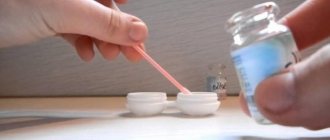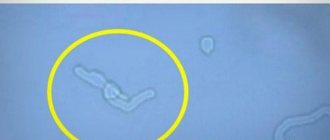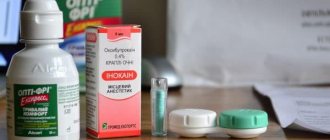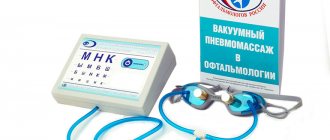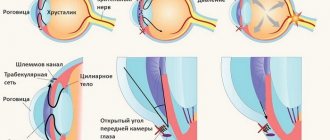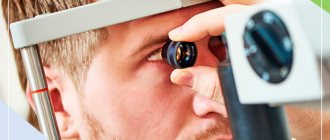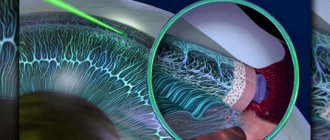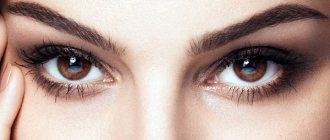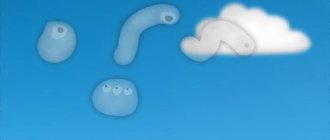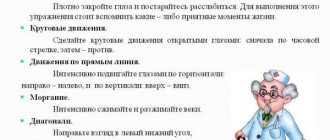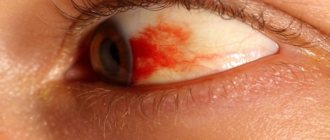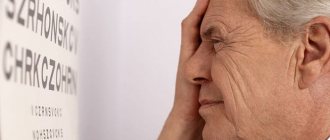Mechanism of action Indications Contraindications Our advantages Prices Reviews
Hirudotherapy is an effective method of treating many diseases using medicinal leeches. Treatment with leeches has been known since the times of ancient Greek medicine; now this method is a progressive trend in medicine. Hirudotherapy is approved by the Russian Ministry of Health and has the State Standard for Medicines.
For this procedure, only one type of leech is used (medical leech, hirudo medicinalis), specially grown for this purpose. Initially, such leeches are “sterile” and cannot introduce infections into the body. Each leech is used only once, so during a hirudotherapy session it is impossible to become infected with blood-borne infections (AIDS, hepatitis, etc.).
Mechanism of action
Treatment with leeches has a complex positive effect on the body, the components of which are reflex, biological and mechanical effects.
The reflex effect of a medicinal leech can be compared with that of acupuncture: the leech sticks to the skin not in any place, but in certain biologically active points (which it itself determines).
The biological effect is realized by injecting into the bloodstream, together with the saliva of a medicinal leech, a huge amount (more than 100) of biologically active substances: enzymes, hormones, vitamins, amino acids, etc. Leech saliva contains a special substance, hirudin, which has a pronounced anticoagulant effect; hirudotherapy is an extremely effective method of preventing vascular thrombosis, strokes and heart attacks.
The mechanical action is achieved by unloading the regional blood flow while the leech is filling with blood.
Hirudotherapy technique
A course of treatment with leeches can only be taken by experienced specialists.
Before we begin treating a hernia with leeches, we carefully examine the patient to determine the cause of the pain, the location of the disc damage, and the presence of contraindications to hirudotherapy. To do this we assign:
- X-ray of the spine.
- Ultrasound of soft tissues of the back.
- CT, MRI (if necessary).
- Blood tests. A test to determine blood clotting is required.
- Urine studies.
If there are no contraindications, the doctor draws up a detailed treatment regimen, which includes hirudotherapy. At the same time, he proceeds from the norms recommended regarding the maximum number of worms to be applied:
- 1 leech sucks up to 15 ml of blood.
- The same amount of plasma comes out after removing the worm.
- You cannot apply more than 7 hirudas in one session, the average number is five.
- The number of hirudes and the duration of the procedure depend on the complexity of the case and the severity of symptoms.
- The standard course of treatment is 8-10 sessions.
- The break between procedures is 3-4 days.
The session takes place in a specially equipped room, with strict adherence to sanitary and hygienic standards. The doctor wears gloves to avoid an accidental leech bite.
The doctor places hirudas on biologically active points that are located along the spinal column and other places. The worm itself chooses the site of the bite, which is usually an inflamed area where there is a lot of stagnant blood that is tasty for it. Giruda remains on the skin until it eats up and falls off on its own.
During the session, the doctor makes sure that the worm does not stick to the place where leeches cannot be placed:
- in places where veins and arteries accumulate;
- in areas where blood vessels are close to the surface of the skin;
- in areas where the skin is too rough and thick.
What types of intervertebral hernias are most difficult to treat?
4 stages of treatment for intervertebral hernia
Preparing the patient for the session
Leeches are very finicky creatures that cannot tolerate strong odors. They will not drink blood if you drank alcohol or smoked the day before, so you need to prepare for the session.
2-3 days before the session, give up alcohol and keep smoking to a minimum. Pay attention to your diet. Before hirudotherapy, do not eat smoked meats, garlic, or onions. On the day of the procedure, do not wear cologne or perfume. The skin should be clean; when showering, use unscented soap.
Where are leeches placed for a lumbar hernia?
Before placing leeches, the doctor determines where the hernia appeared, what complications it caused, and its causes. To do this, he uses the palpation method, X-ray data, ultrasound, blood tests, and urine tests.
Leeches for a lumbar hernia are often placed not only on the lower back, but also on the stomach - the left inguinal area, where the sigmoid colon is located. When inflamed, it releases toxins that enter the lower back, impairing blood circulation, especially near the sacrococcygeal vertebrae. This leads to the development of disc deformation, protrusion, and hernia.
Hirudotherapy for hernia of the lumbar spine is carried out according to different schemes. One of them is like this:
- Using palpation, the doctor finds a pain point on the left side of the abdomen, where he places 1-2 leeches. Then they themselves look for the source of inflammation and pierce the skin above it.
- Then the leeches are placed on the right side.
- The patient turns on his side, the doctor looks for a pain point in the lower back and below. When he finds it, he places the leech 3-4 cm from the vertebra.
This method helps to get rid of pain faster than if you place hirudas only on the lower back. The doctor can also place leeches on the neck and other parts of the back. The saliva of hirudas has a complex healing effect on the body and helps eliminate the cause that provoked disc deformation and hernia.
Read more about lumbar disc herniation in this article.
Placement of leeches for lumbar hernia
Where are leeches placed for a thoracic hernia?
Placing leeches for a thoracic hernia requires special qualifications. The heart is located nearby, so they cannot be used after a recent heart attack or other myocardial problems at the acute stage.
If everything is normal, the doctor places leeches on points along the spine, as well as on the chest, above the projection of the damaged disc. If the pain radiates to other parts of the body, the doctor looks for inflamed areas and applies worms to them. These are mainly the shoulder blades, shoulders, upper or lower abdomen. Hirudas help normalize the functioning of internal organs that have caused degeneration of the thoracic intervertebral disc.
Where are leeches placed for a cervical hernia?
If the cervical discs are damaged, the doctor places leeches in the neck and shoulder blades. Worms quickly find inflamed areas and stick to them. If you treat pain that radiates to the lower back and legs, the doctor can place worms along the entire spine.
What does it feel like?
When a leech pierces the skin, according to patients, unpleasant sensations often appear. They last literally a few seconds, since the worm’s saliva contains painkillers. During sucking, blood circulation starts. The patient may feel warmth and a slight tingling sensation.
After removing the leeches, a feeling of tightness appears, which is a normal reaction to wound healing. A bruise and swelling may appear, which will disappear within 1-2 days from the moment of the bite. A small scar remains, which will disappear within 1-2 months.
After the first procedure, pain in the spine decreases, inflammation disappears, and blood flow improves. My health improves dramatically and my mobility returns. Repeated sessions consolidate the result and neutralize the processes that caused disk damage.
In addition to eliminating pain and inflammation from a hernia, patients mention the following effects after undergoing a course of hirudotherapy:
- normalization of pressure;
- elimination of headaches, migraines;
- disappearance of tingling, numbness in the limbs;
- improvement of physical activity, quality of life.
What feelings shouldn't exist?
It is necessary to stop the procedure if there is a strong fever, fever, or rash. According to doctors, this may be the result of a severe allergic reaction. You should also stop the session if your blood pressure drops, dizziness, pale skin, or faintness appear.
How to remove leeches
The sucking process lasts from 10 to 60 minutes, after which the hirudes fall off on their own. You can’t forcefully remove them, as they may regurgitate the skin back into the wound. If the leech needs to be removed earlier, we use medical alcohol or iodine. Hyrudas do not like strong odors, and will fall off even if you just bring liquid to them.
Most often, leeches disappear on their own
Post-leech bleeding
During 1 procedure, one leech drinks from 3 to 10 mm of blood, a group - from 50 to 700 mm. To do this, she pierces the skin to a depth of 1.5 mm and injects saliva, which contains substances that prevent blood clotting.
When the leech falls off, slight bleeding occurs, and the remaining intercellular fluid and lymph come out along with the plasma. Depending on the organism, the blood clots within 3-24 hours after the leech falls off. After the procedure, wounds cannot be treated; you need to apply a high-quality bandage.
Indications in ophthalmology
The scope of hirudotherapy is extensive. This treatment method is also used in ophthalmology, as an effective means in the complex treatment program for many eye diseases.
1. In the complex treatment of glaucoma, including to relieve the time of an acute attack and after antiglaucomatous surgery.
Hirudotherapy helps normalize intraocular pressure, reduces pain in the eyes, improves hydrodynamics and blood circulation of the eye, which has a beneficial effect on the restoration of visual functions in patients with glaucoma (expanding visual fields, increasing visual acuity).
2. For inflammatory eye diseases - uveitis, iridocyclitis, keratitis, chorioretinitis.
Just a few sessions of hirudotherapy can relieve the symptoms of swelling and acute inflammation of the eye tissues, then the effect of drug treatment is significantly enhanced. The use of a medicinal leech for iridocyclitis not only speeds up the healing process, but also avoids the appearance of synechiae, reduces intraocular pressure, and accelerates the resorption of hypopyon (accumulation of pus in the anterior chamber of the eye). In patients with uveitis, hirudotherapy helps to avoid the formation of rough strands in the vitreous body, which can subsequently cause tractional retinal detachment. The use of medicinal leech therapy sessions from the first days of treatment in patients with chorioretinitis promotes rapid regression of disease symptoms and restoration of visual functions.
3. In the treatment of acute obstruction of the vessels of the retina and optic nerve.
Hirudotherapy is used as an emergency aid and during planned treatment of these pathologies.
4. In the complex treatment of retrobulbar neuritis.
Regardless of the cause of inflammation of the optic nerve, with the use of hirudotherapy, there is a decrease in pain, improved vision, expanded visual fields, and a decrease in the size of the blind spot.
5. After various surgical interventions on the eyes.
The use of a medicinal leech allows you to quickly normalize intraocular pressure in case of a temporary increase in patients who have undergone cataract removal or laser intervention. The method helps to quickly get rid of hematomas and swelling.
6. Cicatricial changes in eye tissue after burns.
Biologically active substances contained in the saliva of a medicinal leech contribute to the effective resorption of scars and their reduction in size, and have a pronounced analgesic effect.
7. Hemorrhages in the eye tissue (hemophthalmos, subretinal hemorrhages).
The use of a medicinal leech enhances the effect of drug treatment, promotes rapid resorption of hemorrhages and shortens the treatment period several times.
8. Retinal dystrophy, epithelial-endothelial dystrophy of the cornea.
How do leeches help with glaucoma?
They can combat acute attacks of increased intraocular pressure and significantly alleviate their condition.
What it helps with:
- normalize blood supply to the eye;
- reduce eye pain;
- restore visual functions, even restore visual acuity.
When treating glaucoma, it is very important to restore microcirculation. It is leeches that can cope with this task, since their saliva is endowed with medicinal properties. It contains medicinal components that help cleanse the blood.
Their saliva contains specific substances that have an antibacterial effect. This fact indicates that saliva is sterile. Once it enters the human blood, it enriches it with 30 healing components. This has a beneficial effect on the entire human body.
Related material: Restrictions and contraindications for people suffering from glaucoma
One of these components is hirudin. It stops blood clotting. Due to this, blood circulation is normalized and lymph outflow is improved. Plus, tissues are renewed and cell growth improves. In rare cases, you may be allergic to this component.
The interesting thing is that leeches bite in the places where they are needed, without making any mistakes. Hirudotherapy can be compared to acupuncture. The wound at the site of the bite will bleed within 24 hours, which is considered normal.
Mostly lymph is released from the wound, which helps get rid of swelling.
Advantages of hirudotherapy in MGK
Hirudotherapy is an effective treatment method used in ophthalmology. MGK doctors use hirudotherapy both as an independent method of treatment and as a component of complex therapy for various eye diseases.
All leeches used during treatment undergo medical control and are used once. After the procedure is completed, the leech is killed. The possibility of infection during the session is excluded.
The number of leeches per session and the duration of the procedure are determined individually and do not affect its final cost. The duration of the course of hirudotherapy is determined by the doctor, taking into account the severity of pathological symptoms and the severity of the disease.
The positive effects of hirudotherapy are observed not only during the procedure, but also for some time after it. This allows you to shorten the period of treatment and recovery after illness, as well as reduce the number of medications used.
Where to place leeches and how to handle them. Can they bite?
Put:
- in the temple area on the side of the unhealthy eye;
- in the area of the second cervical vertebra on the right or left side;
- in the area of the lymph nodes behind or in front of the ear.
Five pieces are taken for one procedure.
The first session lasts about half an hour. The following procedures should be carried out until completely filled. The entire course of treatment consists of 10 procedures with a five-day interval.
Performing the procedure: 3 to 5 worms are placed in the temple area on the side of the affected eye. Before this, the skin should be washed with boiled warm water. The use of alcohol is prohibited. Afterwards, the skin is wiped with sugar syrup or 40% glucose solution.
The worms are placed in a glass. The glass is turned over the desired area (temple or behind the ear) on the side of the unhealthy eye. It’s worth waiting until they start to stick and pour. Next, the glass is removed.
The leeches should suck blood and fall off on their own. They will leave small wounds on the skin that will bleed for a short period of time.
There are cases when all fall away, but one remains. You just need to sprinkle salt on it and it will fall off on its own.
It is not recommended to tear off leeches by force. At the end of the procedure, a cotton-gauze bandage should be applied to the wound. You need to sprinkle a small amount of salt on the used ones, wait until they release blood and immerse them in pure, settled water. Reuse of the same worms is allowed.
There should be an interval of 5 days between procedures. The course can be repeated after one month.
Reviews
Natalya Leonidovna Lapina (68 years old, retired)
At the Moscow Eye Clinic, I underwent a course of treatment with leeches for retinal hemorrhage, which occurred due to poor fundus vessels and high blood pressure.
Within two weeks, my vision was almost restored and, gratifyingly, my blood pressure returned to normal. At first I was wary and, one might say, disgusted about this procedure - but there was no pain or discomfort. I express my sincere gratitude to the entire clinic team for their sensitive attitude. God bless you all.
You can make an appointment and ask questions by calling the clinic or online, using Skype consultation on the website.
Contraindications for the treatment of glaucoma with leeches
Hirudotherapy is a safe treatment method. However, it also has some contraindications.
Hirudotherapy cannot be performed in the following cases:
- the presence of cancer cells in the body (oncological diseases);
- with anemia;
- for hemophilia;
- with low blood pressure;
- pregnant women and women who have undergone a caesarean section;
- in case of individual intolerance to these worms: after the first procedure, the presence of elevated temperature, manifestation of allergies (sneezing, runny nose, lacrimation, swelling and redness in the area of the skin where the leech was, eye pain);
- for blood clotting disorders.
Leeches against glaucoma
Hirudotherapy is used to treat patients with keratitis, glaucoma, impaired blood flow through the retinal vessels, uveitis, and corneal dystrophy. Leeches have a good effect on the patient's condition after cataract removal, with eye burns and iridocyclitis.
Hirudotherapy
The effectiveness of hirudotherapy is associated with the special properties of leech saliva. This liquid contains more than 200 active substances, the complex action of which eliminates signs of inflammation, relieves swelling, improves blood flow through the vessels of the eye, stabilizes metabolism and lymphatic drainage.
The following substances contained in the saliva of leeches have been most studied:
- Hirudin has an anticoagulant effect and thins the blood.
- Destabilase helps to resolve thrombotic masses.
- Hyaluronidase promotes the destruction of connective tissue. As a result, it promotes the healing of swelling, scars and adhesions.
- Orgelase helps the formation of new capillary vessels.
- Apyrase helps cleanse the vessel wall of cholesterol deposits.
- Eglins eliminate the symptoms of inflammation.
- Bradykinins increase the diameter of blood vessels.
- Kininase relieves pain.
Treatment with leeches for glaucoma
Glaucoma is associated with increased levels of intraocular pressure, which leads to damage to the optic nerve fibers. This process is usually irreversible, especially in the absence of treatment.
When performing hirudotherapy, drainage functions improve and the outflow of intraocular fluid increases. This leads to improved nutrition of eyeball cells.
As a result of vasodilatation, intraocular hypertension decreases.
Using leeches for exophthalmos
With exophthalmos, the eyeball protrudes forward. This phenomenon usually serves as a symptom of other diseases of the eyes and body systems.
The causes of exophthalmos lie in inflammation, tumor damage to the orbit, endocrine disorders, congenital glaucoma, high myopia, and eye trauma. Treatment for exophthalmos should eliminate the cause of this condition.
With hirudotherapy, nutrition of the eye tissues is restored and microcirculation is improved. Signs of inflammation and problems with the endocrine system also decrease.
Hirudotherapy technique in ophthalmology
The method of installing leeches depends on the specific disease. Typically, leeches are attached to the temporal and occipital regions, at the site of the projection of the lymph nodes (in front of and behind the auricle).
Contraindications for hirudotherapy
Leeches should not be given to pregnant women, patients with hypotension, hemophilia, anemia, a tumor process, or in the acute stage of a stroke.
The effectiveness of hirudotherapy in ophthalmology
In the case of an acute attack of glaucoma, half an hour is enough to eliminate the symptoms of intraocular hypertension (headache, fog before the eyes, etc.). After three sessions, corneal swelling completely disappears.
In patients with keratitis, after the first session of hirudotherapy, the amount of infiltrate and the area of inflammation are significantly reduced.
With burn scars in the eyelid area, connective tissue formations resolve, and in the case of uveitis, the risk of developing retinal detachment is significantly reduced.
Cost of hirudotherapy for glaucoma
The cost of treatment depends on the number of leeches used. Usually about 5 leeches are used in one session, and the number of sessions is 7-10. The final cost calculation can only be made based on the diagnostic examination data.
SEE ALSO: Aloe in the treatment of glaucoma, folk recipes Ethnic aspects of glaucoma in Mongoloids After surgery to remove glaucoma
Hirudotherapy in the treatment of glaucoma
Hirudotherapy can be translated from Latin as “treatment with leeches.” This method is used in the treatment of many diseases, including glaucoma. He gained his fame in ancient times. And even today, hirudotherapy is quite popular in modern medicine.
Medicinal leeches are grown on specially equipped biological farms. It is impossible to introduce an infection into the patient’s blood, since they are sterile. Each of them is used only once.
Surprisingly, these creatures can detect disease and they only act on the affected areas of the patient. There will be no side effects after hirudotherapy.
Vitaly Ostrovsky
Source: https://ssoch.ru/piyavki-protiv-glaukomy/
